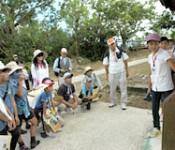
August 26, 2011 Yukiyo Zaha of Ryukyu Shimpo
On August 21, in conjunction with the Urasoe Board of Education, the Urasoe City Guides (headed by Hiromasa Awamori), a nonprofit organization that runs tours of the historical sites and cultural assets of Urasoe City, carried out a tour around Urasoe Gusuku (castle) ruins and Yodore (Ryukyu Royal Mausoleum). The tour is an annual event held during the summer holidays and this year it attracted about 150 participants, including family groups. Five local elementary-school pupils made their debuts as guides introducing people to the history of Urasoe City.
Takushi Elementary School pupils 10 year-old Kaito Omine (fourth grade) and 11 year-old Shotaro Koishi (sixth grade), Kamimori Elementary School pupil Tatsuhiro Nishi (sixth grade), and Urasoe Elementary School sixth grade pupils 11 year-old Shiho Miyagi and 12 year-old Hinako Kawamitsu acted as tour guides for the first time.
They began by participating in a children’s training course for history guides in Urasoe City, before going on to the historical sites and repeatedly practicing their explanations.
The five pupils were excited about the prospect of tour guiding, saying things like, “I’m a little nervous about it,” and “I would really like to deliver clear explanations.”
The participants on the tours were divided into six tour groups and introduced to Urasoe Yodore, which houses the remains of the rulers of the Ryukyu Island such as King Eiso and King Sho Nei, the grave of Fuyu Iha, the father of Okinawaology and Deegu Gama, an Utaki (sacred place) located within Urasoe Gusuku, which local civilians used as a shelter during the Battle of Okinawa.
Along the way, the participants also enjoyed quizzes on the history of Urasoe City.
Awamori said, “I hope that the event will help to create a point of communication between parents and children during the summer holidays.”
Urasoe Elementary School fourth-year student 10 year-old Shiori Miyagi, who took part with her family, said, “I took part because I wanted to find out what kind of gravesites there were in Urasoe City in the past and how long the stone path is. I would also like to become one of the child tour guides.”
(English Translation by T&CT, Mark Ealey)
Go To Japanese
August 27, 2011 Ryukyu Shimpo
The government will provide compensation for the families of local employees whose health was affected by asbestos and who left their jobs on U.S. bases before Okinawa was returned to Japan on May 15, 1972. This measure was set in place on August 26 by means of a notice from the Minister of Health, Labour and Welfare. The government was effectively responding to the new Act on Asbestos Health Damage Relief that was approved at the Upper House plenary session the same day. Hiroshi Zamami, the secretary-general of the Okinawa district of the All Japan Garrisons Forces Labor Union, was pleased with the measure, saying, “We have been concerned about the issue of compensation for former base workers employed on the bases before Okinawa’s reversion to Japan. We are delighted that the Government has instituted the appropriate measures into law.”
Claims for compensation on patients who died from asbestos poisoning but were unaware of the cause of their ill-health had a five-year period of statute of limitations, but the amendment law extends that time limit after death to ten years for the families of deceased patients. Based on this new law, Okinawa military base employees are included in the relief measures prescribed by Minister of Health, Labour and Welfare notice.
According to Masako Zamami, the chief counselor of the Center for Unemployed Workers of U.S. Bases in Okinawa and the person responsible for giving advice on situations in which the employees on bases had their health damaged by asbestos, there were five consultations either from workers who ceased working on a base before Okinawa was returned to Japan, or from the families of such people. Their claims were rejected because the employer had been the United States Government. Zamami said, “There are many former base workers who gave up on claims because the Japanese Government told them that they were not covered, and also many families of deceased base workers who never knew that it was an asbestos-related disease. We must strive to find these victims and their families so we can help them.”
(English Translation by T&CT, Mark Ealey)
Go To Japanese
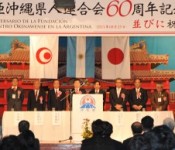
August 27, 2011 Hisao Miyagi of Ryukyu Shimpo, Buenos Aires, Argentina
On August 25 local time, at the Kenjin-Kai Hall, Buenos Aires, Argentina, 250 people of Okinawan origin attended the Argentina Okinawa Kenjin-Kai’s celebration of the 60th anniversary of its foundation. The Okinawa Kenjin-Kai was organized by people of Okinawan origin in 1951, the year that the family reunification program for Okinawan immigration to Argentina recommenced after having been suspended after the Second World War. At the ceremony, the participants paid tribute to the achievements of the people involved in its establishment and vowed to continue passing on the Uchinanchu spirit to the younger generation.
At the ceremony, on the Argentina side there was Teiji Arakaki, the president of Kenjin-Kai and others and the Okinawa Prefecture side included Yoshiyuki Uehara, Deputy Governor; Yoshikazu Tamaki, Vice Chairman of the Okinawa Prefectural Assembly; Toshiyasu Shiroma, Chairman of the Okinawa Municipalities Association and Mayor of Haebaru Town. Chairman Arakaki said, “We are grateful to the founders of the organization for their achievements. We will provide leadership as we move forward, hoping to create and enjoy greater prosperity for the community.”
At the gathering, an Eisa parade was performed by the members of the Argentina branch of the Ryukyukoku Matsuri Daiko and the Okinawa prefectural South America Caravan, and the participants were encouraged to join to the 5th Worldwide Uchinanchu Festival in Okinawa. At the end of the ceremony everyone took part in the kachashi dance.
(English Translation by T&CT, Mark Ealey)
Go To Japanese
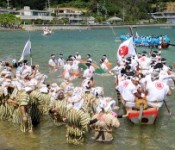
August 25, 2011 Ryukyu Shimpo
The Unjami Festival, an event designated as one of Japan’s significant intangible folk cultural assets, was held in Shioya Bay and other areas of Ogimi Village on August 24.
In the traditional ceremony, participants prayed for a good catch in their region with Kaminchu (sacred people specializing in Ryukyuan religious practices) offering prayers at Asagi (houses of worship) at Taminato and Yako, where gods are summoned for ceremonies and rituals. This was followed by the Ugan Barley dragon boat race and ritual sumo.
It is said that Unjami Festival dates back some 400 or 500 years to the time of the Ryukyu Kingdom. It is held every year in the seventh month of the lunar calendar following the Bon season.
Spectators were served libation after the sacred Kaminchu dressed in white gowns offered prayers at the Asagi in Taminato.
In the Ugan Barley dragon boat race, the men brought the “Gods” on board three boats, which then raced from the Taminato area to Shioya. On the shore women waded into the water up to their hips, clapping their hands and beating drums as they greeted the boats.
Sixty year-old Akira Chinen, head of the Shioya district, said, “I am glad that this tradition continues. We do face issues when it comes to passing on these practices, but we want to make concerted efforts to work together in the community to resolve them.”
(English Translation by T&CT, Mark Ealey)
Go To Japanese

Go To Video
August 26, 2011 Ryukyu Shimpo
On August 25, Tomishiro Chuo Hospital (Director Yoshiki Shiohira), located in Tomigusuku City, established a medical alliance with a hospital group of the Bangkok Dusit Medical Services Public Company Limited, which, together with its subsidiaries, operates hospitals in Thailand. Both hospitals will share information on matters such as patients’ records, and to facilitate the mutual introduction and acceptance of patients who need medical treatment for a sudden illness or injury during their travels to Okinawa and Thailand, and when they are returning to their countries.
It has been a challenge for the Okinawa tourism industry to respond to sudden illness of foreign tourists during their stay in Okinawa. Shiohira said, “The number of people coming here from other countries will continue to increase, and so we will inevitably be involved in supporting them in times of medical emergency. We will provide a system capable of coping with the sudden illness of foreign tourists.”
As part of its medical tourism services, Tomishiro Chuo Hospital has provided cancer health checks for Chinese visitors since 2010. The hospital has strengthened its support system for Chinese by employing Chinese and Taiwanese staff and interpreters, and has introduced the China Union Pay card system, China’s largest credit card.
The president of the hospital stated, “Okinawa has geographical advantages and so there will be increased tourism from Asian countries. We want to assist them from a medical standpoint.”
In addition to the Tomishiro Chuo Hospital in Okinawa, the Bangkok hospital group has already established partnerships with 12 hospitals in other parts of Japan.
(English Translation by T&CT, Mark Ealey)
Go To Japanese
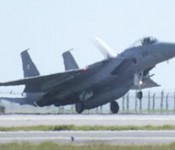
August 25, 2011 Ryukyu Shimpo
Eleven F-15s fighter planes and one T-4 training aircraft of the Hyakuri Air Base (Ibaraki Prefecture) of Japan Air Self-Defense Force (JASDF) arrived at Naha Air Base on August 24 on a temporary transfer to carry out training.
The fighter squadron will be stationed in Okinawa for about one month. Local residents are concerned that noise pollution will be increased during this period by about 1.8 times the normal level in and around the base.
The first four F-15s arrived at Naha Base at 3:00pm, August 24, followed by a further seven planes from Hyakuri Air Base at 4:00pm. One T-4 training plane also arrived that morning.
The Naha Base official initially announced that twelve F-15s and two T-4s would move to Naha. It is not known why the other two planes have not yet come.
According to a Naha Base official, the Hyakuri Air Base has had its power consumption reduced by about 20% in July in comparison to the same month the previous year, so F-4 fighter planes based at Hyakuri were relocated to Chitose Air Base, in Hokkaido, from July 5 to August 4.
The F-15s at Naha Air Base have not resumed full flight training since one crashed into the East China Sea in July. The number of flights increasing at this base may further intensify concerns of local residents.
(English Translation by T&CT, Mark Ealey)
Go To Japanese

Go To Video
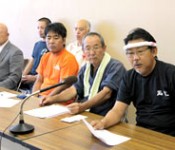
August 23, 2011 Ryukyu Shimpo
Owners of Okinawa soba restaurants have established the Okinawa Soba Development and Heritage Association in order to promote Okinawa soba (a type of noodle-soup eaten in Okinawa). On August 22, the restaurant owners, who plan to cooperate through exchange and training courses, held a press conference at the Prefectural Government Office to announce the establishment of the Association.
Hiroshi Chinen (owner of Udunyama) assumed the role of chairman, with Chotetsu Tamaki (owner of Tamaya) and Yasuhiro Takehara (owner of Awase Soba Dining) both being appointed as vice-chairmen. Kenichi Dohi (head of Sun Shokuhin Co., Ltd.) will serve as an adviser to the Association.
Masashi Nozaki, a staff member its head office, talked about the importance of establishing the Association, saying, “The owners of Okinawa soba restaurants face common issues such as the decreasing numbers of people prepared to take over their businesses and the need to attract more customers. They feel that they have done as much as they can by themselves to solve these issues, so we thought that if they were to cooperate with each other, they may be able to improve the situation.”
The Association has an annual membership fee of 30000 yen and is now calling for members.
For further details, call Masashi Nozaki of the head office of Okinawa Soba Development and Heritage Association at 098 (886) 2200 or 090 (3794) 9346.
(English Translation by T&CT, Mark Ealey)
Go To Japanese
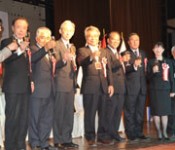
August 22, 2011 Hisao Miyagi reporter of Ryukyu Shimpo, in Lima City
On August 20, the Peru Okinawa Kenjin-Kai held a ceremony marking the 100th anniversary of its foundation at the Okinawa Kenjin-Kai Hall, in Lima City, Peru, with approximately 250 people of Okinawan origin attending. Participants at the ceremony praised the achievements of their forerunners, including the 30 people who set up the Okinawa Youth Fellow Association in 1911 as the predecessor to the Okinawa Kenjin-Kai, and vowed to come together again at the 5th Worldwide Uchinanchu Festivall in Okinawa in October.
At the ceremony, on the Peruvian side, there was Victor Asato, chairman of the Peru Okinawa Kenjin-Kai; Mieko Moromizato chairwoman of the Women’s Association; Luis Uemura, chairman of Japanese Association of Peru, and on the Okinawan side, Deputy Governor Yoshiyuki Uehara; Yoshikazu Tamaki vice chairman of Okinawa Prefectural Assembly and Toshiyasu Shiroma chairman of Okinawa municipalities (Mayor of Haebaru Town).
Chairman Asato spoke about the achievements of their forerunners, saying, “We will make every effort to pass on to the next generation the ideals, values and traditions that we have inherited from our ancestors. We, Okinawan Peruvians as one.”
Deputy Governor Uehara read a message from Governor Hirokazu Nakaima stating, “Underpinned by their love for their homeland, our predecessors played an active role in all aspects of Peruvian society, including politics, economy, education. We want you to be even more active to help gain momentum as we move forward from the 100th anniversary of the establishment of the Kenjin-Kai.” He presented certificates of appreciation to past chairpersons of the Kenjin-Kai and the Women’s Association.
(English Translation by T&CT, Mark Ealey)
Go To Japanese
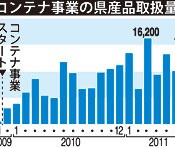
August 24, 2011 Sakae Toiyama, reporter of Ryukyu Shimpo
The Okinawa Prefectural Government (OPG) has launched a project hiring room in air cargo containers to carry Okinawan products from Naha Airport to five Asian cities such as Hong Kong, Seoul and Shanghai. Designed to expand overseas sales channels for Okinawan products, the project has got off to a good start.
The volume of products carried by air reached a monthly average of 9.4 tons in 2010, about a 24-fold increase over the 0.4 ton of November 2009, before the project started. However, in the first half of 2011, January to June, it accounted for only 0.2% of Okinawan products in terms of volume handled at Naha Airport for cargo with an overseas destination. OPG is calling on companies in the prefecture to make greater use of the initiative.
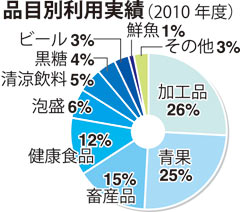
Figures for commodity items utilizing the project in 2010.
OPG has supported this project since December 2009, taking advantage of the opportunity offered by All Nippon Airways when it launched an international cargo hub operation at Naha Airport. The transaction volumes of Okinawan products vary each month, depending on the situation. Volume handled decreased for several months following the Great East Japan Earthquake and there was a temporary halt of local distribution operations during
Shunsetsu (Lunar New Year), but in general it is going smoothly. Transaction volume in March was 6.2 tons, the highest ever figure for one month, due to the fact that an exhibition of products was being held in Hong Kong that month.
By category of available product in 2010, processed foods such as pork luncheon meat and salt accounted for the largest proportion at 26%, green goods such as goya and sweet potatoes accounted for 25%, livestock products such as pork for 15%, health food related items such as fucoidan for 12% and awamori for 6%. In terms of destinations, Hong Kong is the most common, followed by Taiwan, Thailand, Shanghai and Korea. Recently, the volume of items exported to Thailand has steady increased, such as mushrooms, including Okinawan bunashimeji.
Since last year, Okinawan confectionery maker Nampo Trade Co., Ltd., which utilizes this initiative, has been selling 50 of its items, including its flagship products beniimo-tart and shio-chinsukou at high-end supermarkets in Hong Kong. Mutsuko Asato, the company’s director of business planning, said, “The number of repeater tourists to Okinawa has been increasing. But in inverse proportion to that, the average amount of money spent by customers has decreased. We think that with fewer children around, the domestic confectionery market will reach its peak in the not-too-distant future, so we have to extend our business into the fast-growing Asian markets.” She also said that they will continue to develop products tailored to the tastes of health-conscious customers in Asia and will work to further gear up for exports.
Tatsuzo Kinjo, who is responsible for the airfreight container project and is chief of the overseas section of Okinawa Prefectural Public Corporation for Products, said, “We have some sales channels for products in Hong Kong, but we need Okinawan products to broaden those channels by increasing their sales. However, the amount of sales for China, the market that we are aiming for, accounts for only 2-3% of our total business. We intend to tap into the Chinese market, and at the same time to enhance the power of the Okinawan brand of products in future.”
(English Translation by T&CT, Mark Ealey)
Go To Japanese
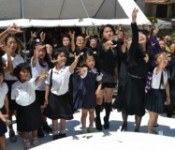
August 23, 2011 Ryukyu Shimpo
The 2011 memorial service for the victims of the sinking of the Tsushima-Maru, a tragedy in 1944 in which the submarine USS Bowfin sank an unmarked Japanese passenger-cargo ship carrying hundreds of schoolchildren, was held at the Kozakura-no-To monument in Wakasa, Naha City on August 22. The memorial service was organized by the Tsushima-Maru Memorial Foundation.
About 350 survivors and bereaved family members attended the service, in which they prayed for the repose of the souls of those who lost their lives in the tragedy.
Actress Mayu Saegusa, who created and wrote Nuchi du Takara (Life itself is our treasure), a play based on the tragedy, and 13 elementary-school children of Naha City, appeared on stage to sing two songs, including Furusato (My Hometown). Then those in attendance let loose rice paper butterflies into the skies as they prayed for the victims and for peace. There was also a minute’s silence in honor of the victims of the Tsushima-Maru tragedy and of the Great East Japan Earthquake.
In a determined tone, Masakatsu Takara, president of the Tsushima-Maru Memorial Foundation said, “The staff of the Tsushima-Maru Memorial Museum will make every effort not to let the fire of peace go out and to make better lives for children.”
Eighty year-old Tsuneko Maria Miyagi Bartruff, one of the survivors of the tragedy, who has attended the memorial service each year from California, lost her grandmother, her younger brother and a cousin in the tragedy when she was just 14 years old.
When the ship went down she was hurled out into the sea, where she was attacked by sharks. She survived a four-day ordeal in the water, her left thigh bitten by sharks as she struggled to swim away.
Miyagi said, “Many years have passed, but I will never forget the tragedy. I still have nightmares in which I see sharks coming to bite me.”
She continued, “I was the only one of my family to survive, so I feel so sorry for my family members who were killed, but I would like to live on for their sake.”
(English Translation by T&CT, Mark Ealey)
Go To Japanese

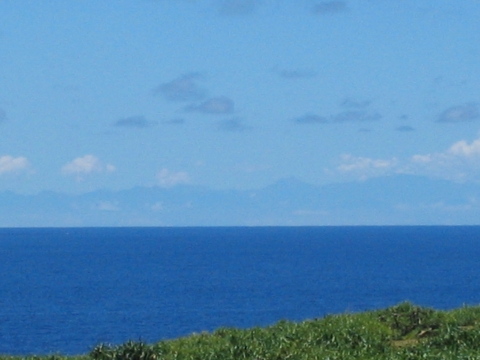
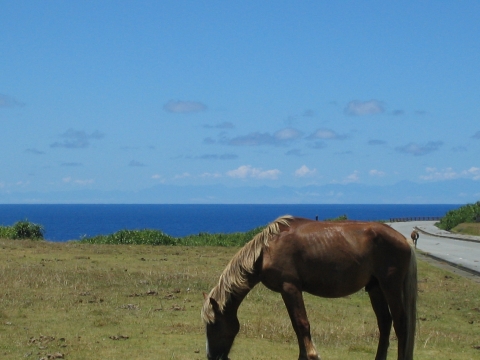










 Webcam(Kokusai Street)
Webcam(Kokusai Street)


